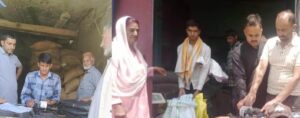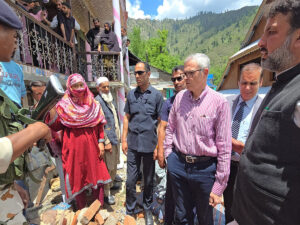J&K administration announces Rs 129 cr initiative to reduce fodder deficit, boost livestock sector
Jammu, Mar 17 (PTI) Jammu and Kashmir administration has announced a Rs 129.05 crore initiative to reduce fodder deficit and boost livestock sector under the Holistic Agriculture Development Programme (HADP) in the union territory, a senior government official said on Friday.
Additional Chief Secretary, Agriculture Production Department, Atal Dulloo said over the years, livestock husbandry has emerged as a crucial growth engine for sustainable and equitable development, which is vital for uplifting the socio-economic status of farming communities in Jammu and Kashmir.
“An apex committee has devised a comprehensive plan under HADP, which amounts to Rs 129.05 crore, to mitigate the fodder shortfall in the UT by 80 per cent. The primary objective of this programme is to augment the agricultural and livestock sectors and equip farmers with vital resources such as financial assistance, improved seeds and technical guidance to amplify productivity, profitability, and overall economic progress of the area,” he said.
Further, he said the government is “working closely with various stakeholders, including agricultural universities, research institutes, and industry experts to achieve this goal.”
Dulloo said livestock rearing in Jammu and Kashmir incurs a significant cost, with 75 per cent of the input cost attributed to feed and fodder.
“The region is home to a diverse range of animals, including 31.45 lakh bovines, 45 lakh sheep and goats, 73 lakh backyard poultry birds and 2 lakh other animal species. Additionally, around five crore commercial broiler birds are being reared in the region,” he said.
The annual requirement for green fodder is approximately 139 lakh metric tonnes, while the dry fodder requirement is around 58.53 lakh metric tonnes.
“In particular, there is a deficit of 40.93 per cent in fodder availability in the region, with a higher deficit of 48.63 per cent in the Kashmir division compared to 32.27 per cent in the Jammu division. Only four per cent of the total cultivable land is under fodder production at present,” he said.
Each year, the official said Jammu and Kashmir imports a significant amount of animal feed with 9,000 metric tonnes of feed, 10,000 metric tonnes of green fodder and 5,000 metric tonnes of dry fodder being imported, which results in a substantial loss to the exchequer.
Moreover, Dulloo said Jammu and Kashmir has significant potential for fodder cultivation. “The region has a large rangeland area of 1.19 lakh hectares, which can support livestock-based livelihood systems.
“Additionally, there are 2.15 lakh hectares of orchards that hold potential for intercropping of fodder crops production, known as the Horti-pastoral system. Field crops, such as paddy, maize, and wheat, are grown over 5 lakh hectares, producing large quantities of residues that serve as dry fodder for winter,” he said.
According to the Additional Chief Secretary, the region produces around 9.9 lakh tonnes of food grains, yet there is a deficit of 21.70 per cent, resulting in minimal allocation of land for fodder crop production.
The proposed plan aims to address the problem of fodder unavailability in the union territory through two approaches — short-term mitigation and medium-term solutions, he said.






